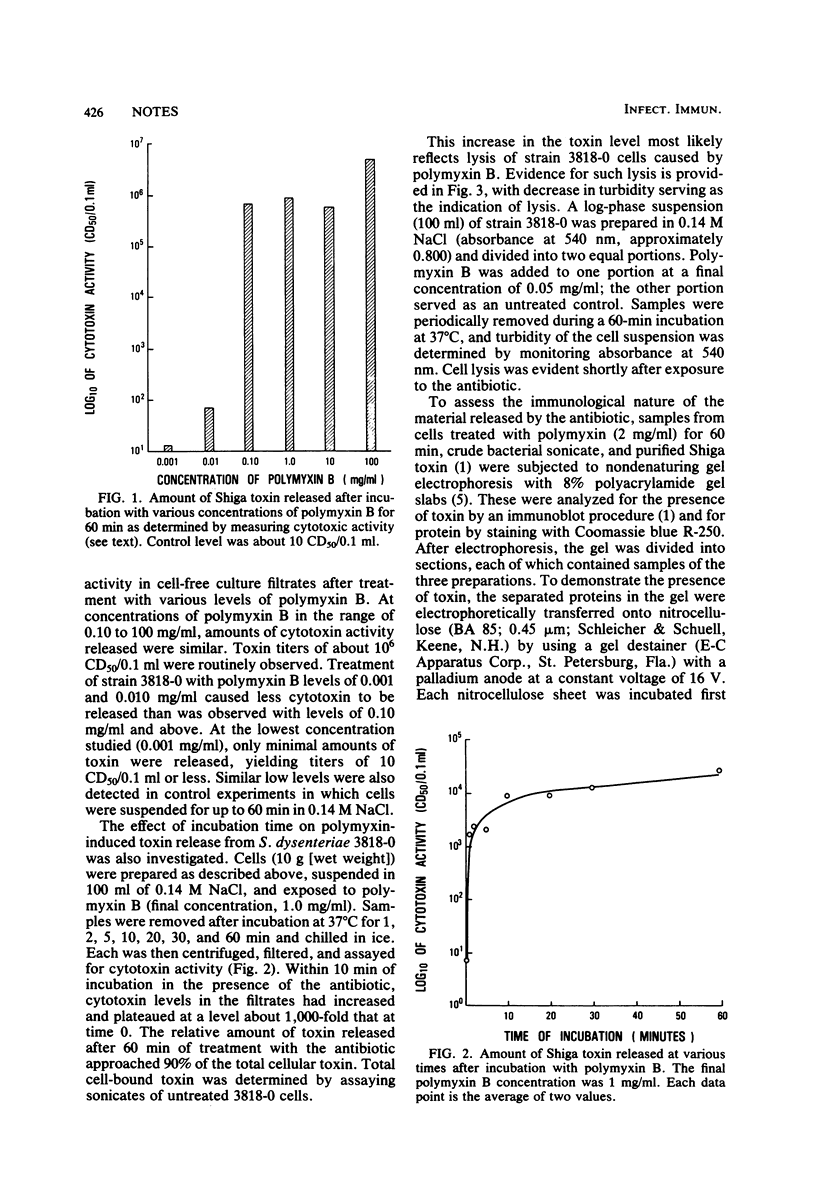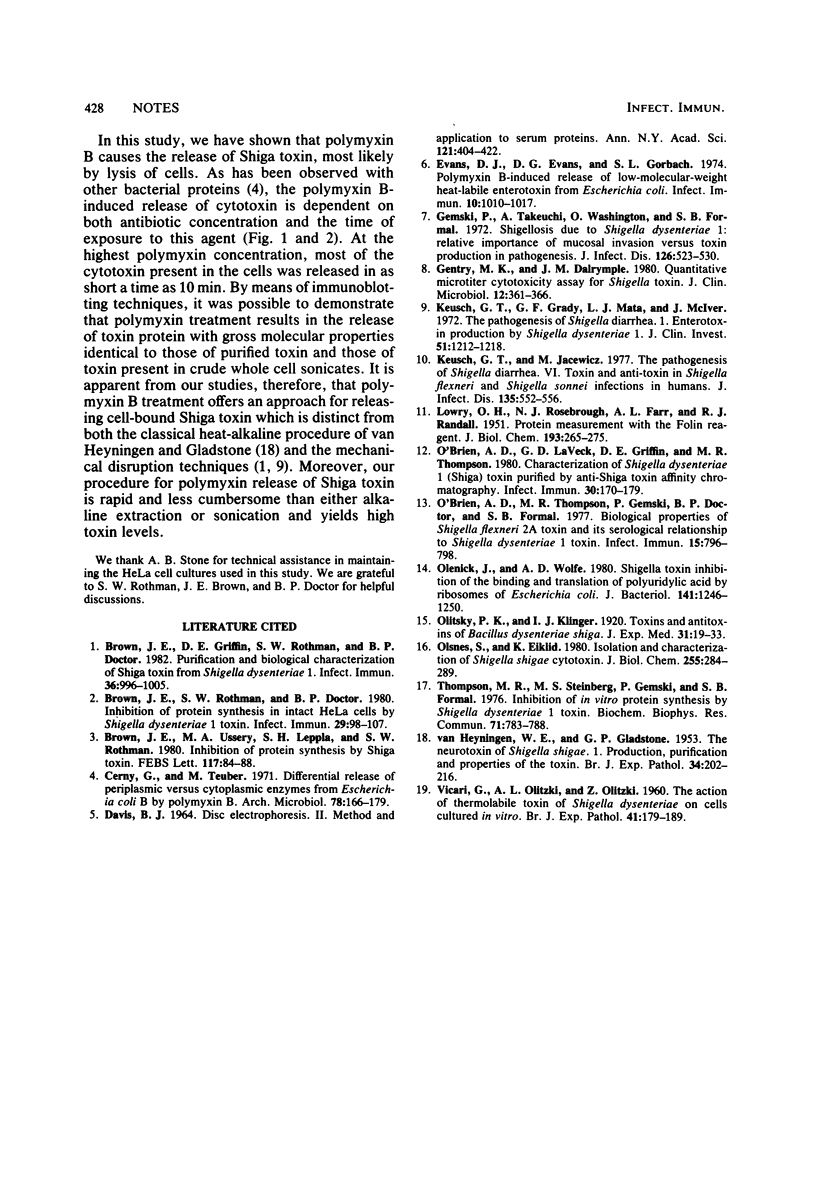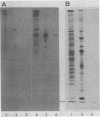Abstract
Release of Shiga toxin from Shigella dysenteriae 1 was found to occur after exposure to polymyxin B. The amount of toxin released was dependent on both the polymyxin concentration and time of incubation. An immunoblot characterization of the Shiga toxin released by polymyxin treatment demonstrated that it is electrophoretically similar to purified Shiga toxin and to Shiga toxin present in crude bacterial sonicates of S. dysenteriae 1 cells.
Full text
PDF



Images in this article
Selected References
These references are in PubMed. This may not be the complete list of references from this article.
- Brown J. E., Griffin D. E., Rothman S. W., Doctor B. P. Purification and biological characterization of shiga toxin from Shigella dysenteriae 1. Infect Immun. 1982 Jun;36(3):996–1005. doi: 10.1128/iai.36.3.996-1005.1982. [DOI] [PMC free article] [PubMed] [Google Scholar]
- Brown J. E., Rothman S. W., Doctor B. P. Inhibition of protein synthesis in intact HeLa cells by Shigella dysenteriae 1 toxin. Infect Immun. 1980 Jul;29(1):98–107. doi: 10.1128/iai.29.1.98-107.1980. [DOI] [PMC free article] [PubMed] [Google Scholar]
- Brown J. E., Ussery M. A., Leppla S. H., Rothman S. W. Inhibition of protein synthesis by Shiga toxin: activation of the toxin and inhibition of peptide elongation. FEBS Lett. 1980 Aug 11;117(1):84–88. doi: 10.1016/0014-5793(80)80918-5. [DOI] [PubMed] [Google Scholar]
- Cerny G., Teuber M. Differential release of periplasmic versus cytoplasmic enzymes from Escherichia coli B by polymixin B. Arch Mikrobiol. 1971;78(2):166–179. doi: 10.1007/BF00424873. [DOI] [PubMed] [Google Scholar]
- DAVIS B. J. DISC ELECTROPHORESIS. II. METHOD AND APPLICATION TO HUMAN SERUM PROTEINS. Ann N Y Acad Sci. 1964 Dec 28;121:404–427. doi: 10.1111/j.1749-6632.1964.tb14213.x. [DOI] [PubMed] [Google Scholar]
- Evans D. J., Evans D. G., Gorbach S. L. Polymyxin B-Induced Release of Low-Molecular-Weight, Heat-Labile Enterotoxin from Escherichia coli. Infect Immun. 1974 Nov;10(5):1010–1017. doi: 10.1128/iai.10.5.1010-1017.1974. [DOI] [PMC free article] [PubMed] [Google Scholar]
- Gemski P., Jr, Takeuchi A., Washington O., Formal S. B. Shigellosis due to Shigella dysenteriae. 1. Relative importance of mucosal invasion versus toxin production in pathogenesis. J Infect Dis. 1972 Nov;126(5):523–530. doi: 10.1093/infdis/126.5.523. [DOI] [PubMed] [Google Scholar]
- Gentry M. K., Dalrymple J. M. Quantitative microtiter cytotoxicity assay for Shigella toxin. J Clin Microbiol. 1980 Sep;12(3):361–366. doi: 10.1128/jcm.12.3.361-366.1980. [DOI] [PMC free article] [PubMed] [Google Scholar]
- Keusch G. T., Grady G. F., Mata L. J., McIver J. The pathogenesis of Shigella diarrhea. I. Enterotoxin production by Shigella dysenteriae I. J Clin Invest. 1972 May;51(5):1212–1218. doi: 10.1172/JCI106915. [DOI] [PMC free article] [PubMed] [Google Scholar]
- Keusch G. T., Jacewicz M. The pathogenesis of Shigella diarrhea. VI. Toxin and antitoxin in Shigella flexneri and Shigella sonnei infections in humans. J Infect Dis. 1977 Apr;135(4):552–556. doi: 10.1093/infdis/135.4.552. [DOI] [PubMed] [Google Scholar]
- LOWRY O. H., ROSEBROUGH N. J., FARR A. L., RANDALL R. J. Protein measurement with the Folin phenol reagent. J Biol Chem. 1951 Nov;193(1):265–275. [PubMed] [Google Scholar]
- O'Brien A. D., LaVeck G. D., Griffin D. E., Thompson M. R. Characterization of Shigella dysenteriae 1 (Shiga) toxin purified by anti-Shiga toxin affinity chromatography. Infect Immun. 1980 Oct;30(1):170–179. doi: 10.1128/iai.30.1.170-179.1980. [DOI] [PMC free article] [PubMed] [Google Scholar]
- O'Brien A. D., Thompson M. R., Gemski P., Doctor B. P., Formal S. B. Biological properties of Shigella flexneri 2A toxin and its serological relationship to Shigella dysenteriae 1 toxin. Infect Immun. 1977 Mar;15(3):796–798. doi: 10.1128/iai.15.3.796-798.1977. [DOI] [PMC free article] [PubMed] [Google Scholar]
- Olenick J. G., Wolfe A. D. Shigella toxin inhibition of binding and translation of polyuridylic acid by Escherichia coli ribosomes. J Bacteriol. 1980 Mar;141(3):1246–1250. doi: 10.1128/jb.141.3.1246-1250.1980. [DOI] [PMC free article] [PubMed] [Google Scholar]
- Olsnes S., Eiklid K. Isolation and characterization of Shigella shigae cytotoxin. J Biol Chem. 1980 Jan 10;255(1):284–289. [PubMed] [Google Scholar]
- Thompson M. R., Steinberg M. S., Gemski P., Formal S. B., Doctor B. P. Inhibition of in vitro protein synthesis by Shigella dysenteriae 1 toxin. Biochem Biophys Res Commun. 1976 Aug 9;71(3):783–788. doi: 10.1016/0006-291x(76)90899-8. [DOI] [PubMed] [Google Scholar]
- VAN HEYNINGEN W. E., GLADSTONE G. P. The neurotoxin of Shigella shigae. I. Production, purification and properties of the toxin. Br J Exp Pathol. 1953 Apr;34(2):202–216. [PMC free article] [PubMed] [Google Scholar]
- VICARI G., OLITZKI A. L., OLITZKI Z. The action of the thermolabile toxin of Shigella dysenteriae on cells cultivated in vitro. Br J Exp Pathol. 1960 Apr;41:179–189. [PMC free article] [PubMed] [Google Scholar]



